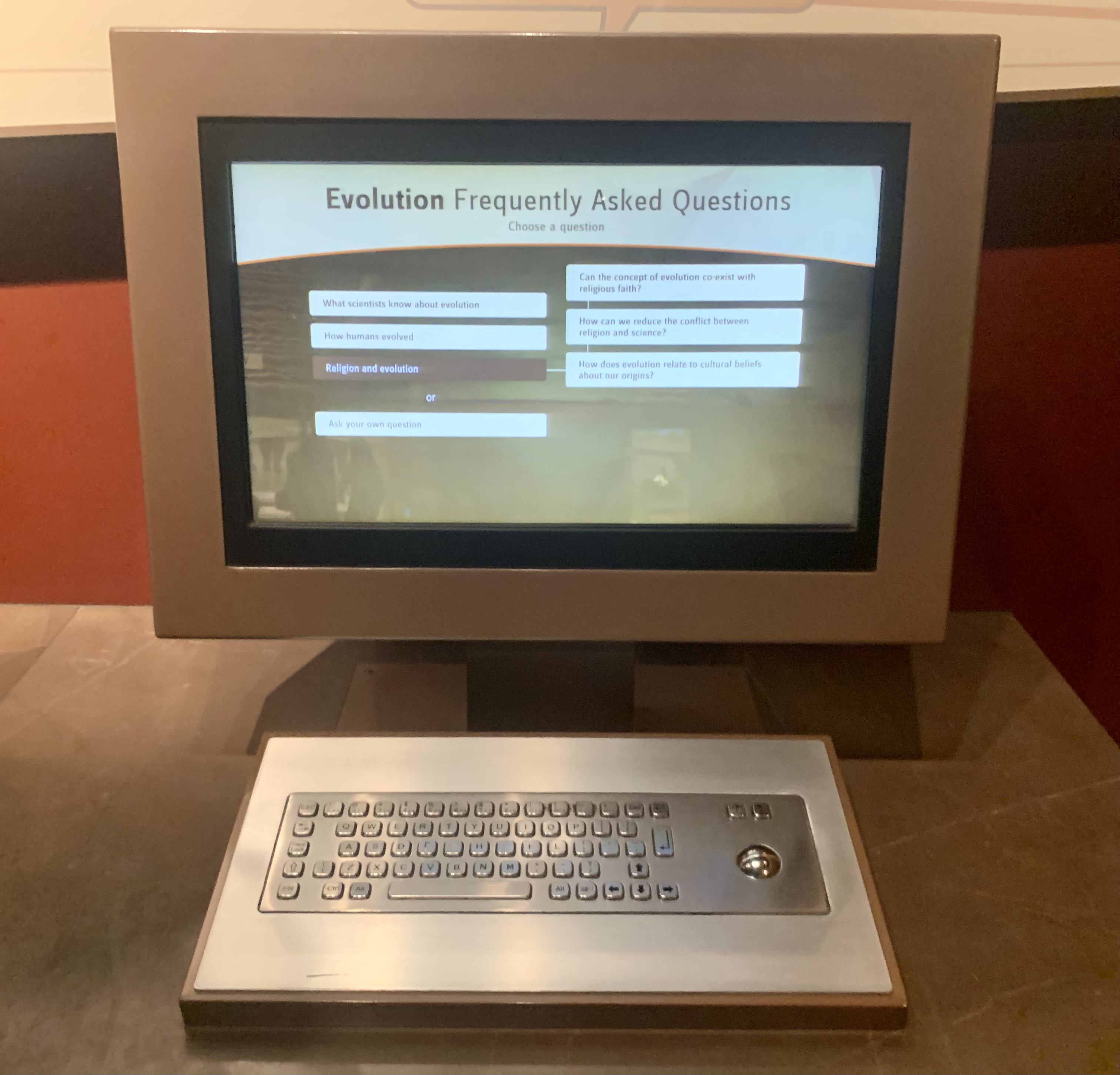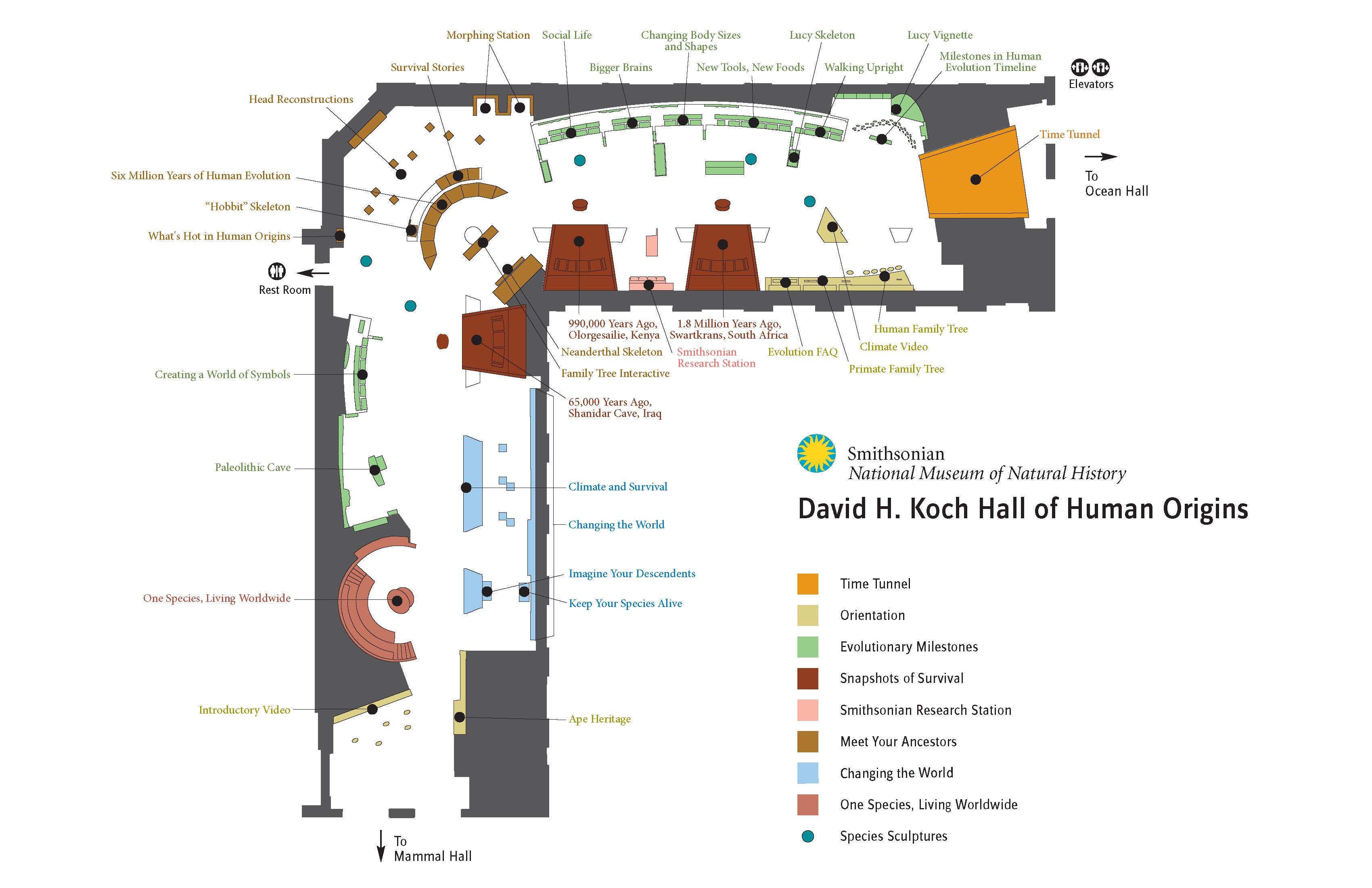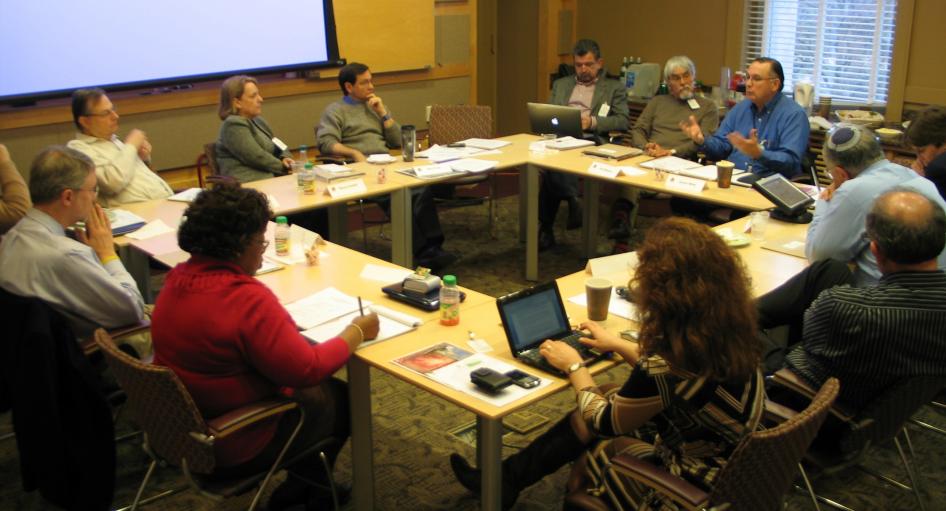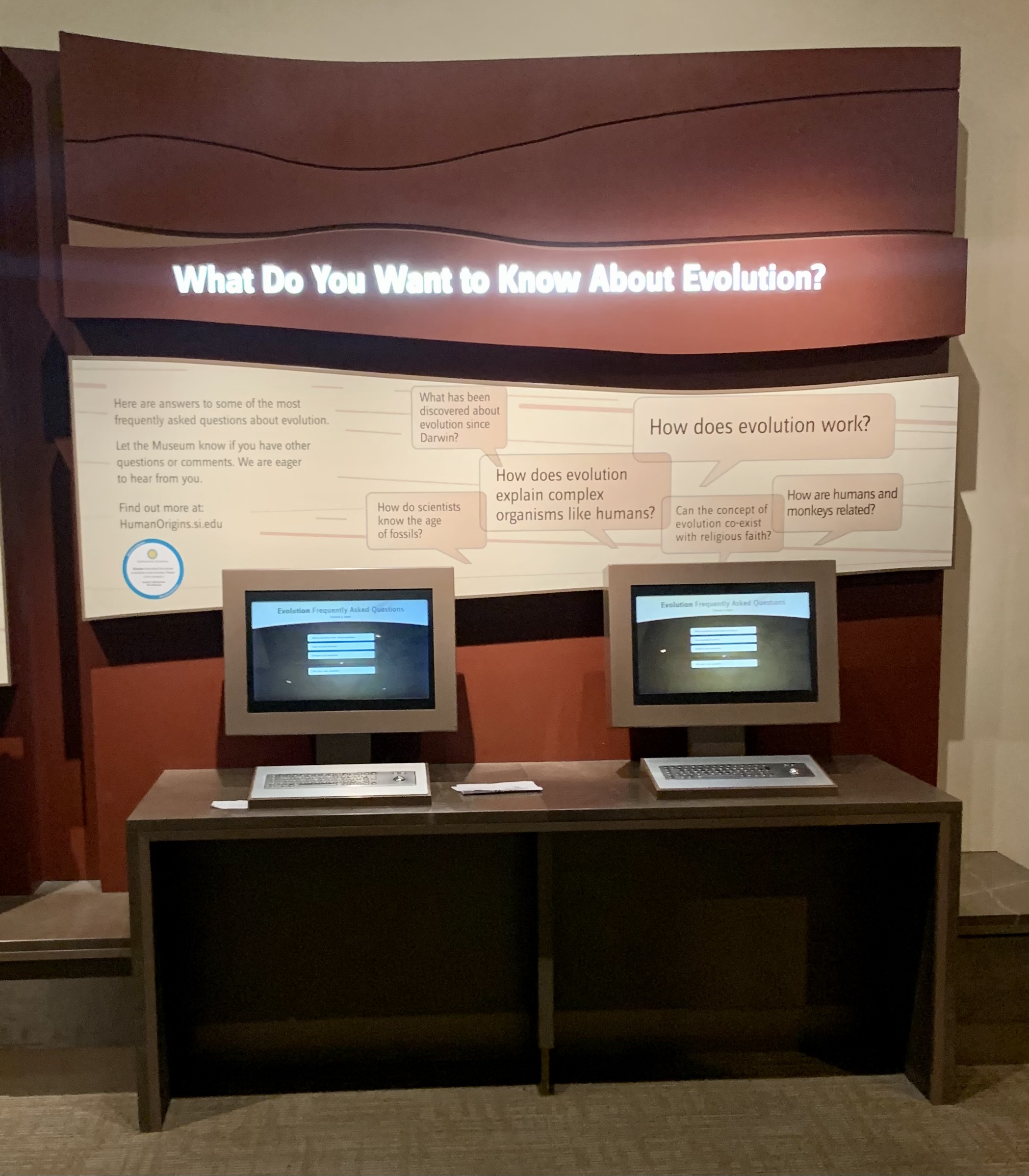XIV. Digital Dialogues About Human Evolution: A Case Study of Frequently Asked Questions (FAQs) Computers at the Smithsonian’s Hall of Human Origins
NATURAL HISTORY MUSEUMS AND EVOLUTION
How should science museums handle doubt and alternative belief systems when curating scientific knowledge? The Hall of Human Origins exhibit in the Smithsonian Museum of Natural History (NMNH) has set out to explore some Frequently Asked Questions like these through their installation of various computers around the exhibit which ask visitors to engage with topics like religion, science, and methodologies. During the exhibit design process, the curation team made the decision to install two interactive Evolution Frequently Asked Questions (FAQs) computers to provide insight into the methods of paleoanthropological science and questions of how Human Evolution occurred. So, why is it that these particular khaki-colored unpretentious-looking computers were chosen to mediate questions between the research scientists and visitors?
At first glance, the nature of exhibits and education about evolution in America calls for meaningful engagement with visitors’ questions and doubts about the science behind the exhibit.1 The Evolution FAQ computers handle rather difficult questions about methodologies and religion, and this investigation critically examines this digital engagement in public dialogue happening through these kiosks. The charmingly plain appearance of the computer interface complements the environmental and “natural” theme present throughout the exhibit.
Near the entrance to the Ocean Hall, the visitor encounters two khaki-colored computer monitors with matching metal keyboards. These Evolution FAQ computers ask hard-hitting questions like “Can the concept of evolution co-exist with religious faith?” and “How can we reduce the conflict between religion and science?”. Unlike other monitors and technologies in the hall, the FAQ computers have a touchscreen interface, stainless steel keyboard, and trackball mouse. Users are invited to choose from a variety of questions that ask the research scientists about their methodologies, the mechanisms of human evolution, and religion’s relationship with evolution.
Besides the categories of the frequently asked questions, visitors have the opportunity to “Ask your own question,” and can type their questions into the computer to be read by the exhibit educator later on. Some of these user-generated questions are used to modify and develop new FAQs and content. It is the technological choices behind the FAQs computer and the “ask your own question” feature that are central to this investigation. Why is this particular style of computer interface and public engagement present at the Human Origins exhibit? To what extent was this installation driven by the desire to install technology into the exhibit? How are alternative belief systems viewed and framed through the museum educators’ discussions and the exhibit itself? It is these questions about the technology and its style that are central to the investigation.
On Monday November 1st 2021, I met virtually with Dr. Briana Pobiner on Zoom to discuss the installation of the Evolution FAQs computers and the use of technology in the Hall of Human Origins exhibition. The goal of the interview was to understand how the Hall of Human Origins curation team perceives the use of technology in their exhibit. The Evolution FAQs computers allow for a dialogue between visitors and researchers on a public platform. In addition to questions about methodology, religion, and how humans evolved, users can ask their own questions to be viewed by the exhibit’s educator later on. The computer then notifies users that their questions can be posted on the computer and the exhibit’s website. Another aim of this interview was to trace the user’s question, observe how the question is answered, and analyze how visitor data is collected and used in the FAQ computer exhibit.
In 2007, Rick Potts - a paleoanthropologist who researches human prehistory - spearheaded the campaign to open a Human Evolution exhibit in the Smithsonian Museum of Natural History, which had been a goal of his since he joined the Smithsonian in 1985. When the exhibit opened in March of 2010, paleoanthropologists, geologists, and ecologists finally displayed a massive record of fossil and artifact data from field sites linked to human evolution. It is commonly believed that a tension exists in the United States between religious believers and evolutionary scientists and the curation team consistently engages in meaningful discussions about philosophy and sensitive exhibit design. Core to this mission was the development of a Broader Social Impacts Committee, composed of individuals from all across the US who participate in these discussions to make the museum more inclusive and engaging to its diverse national audience. This effort emphasizes the Human Origins team’s dedication to inclusivity and public engagement as it materializes in the design and phrasing of frequently asked questions. Research into the exhibit, the evolution education literature, and a conversation with Smithsonian research scientist and Human Origins education and outreach coordinator Dr. Briana Pobiner supports the idea that such values towards public education and the perceived contention of evolution education in the US are centered in the design of the Evolution FAQ computers. There is a lot to be discovered in the Smithsonian Hall of Human Origins, including digital interfaces where the user can better understand their own beliefs in reference to human evolution.
THE ROLE OF RELIGION AND TECHNOLOGY IN A HUMAN EVOLUTION EXHIBIT
The Smithsonian Museum of Natural History in Washington, DC is known for its interactive exhibits and public outreach programs. Public engagement series like HOT (Human Origins Today) Topics in Human Evolution and virtual seminars already open the exhibit to public dialogue and interaction. These events invite the public to learn and ask questions about developing topics in paleoanthropology and related fields. It is at these seminars where scholars engage with the public’s questions as they pertain to the science-in-the-making being discussed.
In an editorial in The American Biology Teacher, Dr. Briana Pobiner writes about how she developed her lifelong love of paleoanthropology: “All of a sudden, science started to take on an entirely new meaning for me, because it was about ME. It was about the deep history and unity of ALL OF US.”2 Human Evolution in this way is viewed to be inviting as a commonality and a uniting narrative. So, why is it that technology is included in an evolution exhibit where fossils, artifacts, and text are the primary sources of evidence? The Human Origins team believes that technology is a way to have visitors engaged with the material. The Hall of Human Origins is filled with screens for viewing content and there are various stations where visitors can generate their own content or play games. For example, the “morphing station” is an incredibly popular interactive where users can take a photo of themselves and the software will produce a merged image of the user and an image of a Neanderthal or Australopithecus, resulting in what the viewer would look like if they were a member of that species. The Hall of Human Origins is clearly designed to be contemplative and engaging, and this is evident through their dedication of several spaces to technology and artistic representations of the faces of ancient relatives. The Evolution FAQ computers follow this theme of visitor engagement and fit into the natural theme present across the exhibit displays.
There still exists a significant population of the US that still does not accept the conclusions of evolutionary science.3 Human Evolution is considered both a historical and biological science. Its research findings are starkly different from creationist origin stories and other narratives from religious communities. Gallup polls on the “Views of Origin of Human Beings” show that a large percentage of the American public believes that human beings were either created by a God and remain in the same form, or that God was the guiding agent of Human Evolution.
In a study that interviewed high school teachers about evolution education, it was found that teachers perceived the topic of evolution to be controversial, although none of the teachers were able to explain an event or known cause of this controversy.4 This discrepancy between evolution education and public acceptance of this science drives Dr. Pobiner’s work as a science educator and researcher. In 2016, she wrote about the obstacles and opportunities that exist when presenting evolutionary science that includes human beings. Here, it is shown that mistrust in science can be stimulated by these discussions, so an ethic of transparency is crucial to effectively teach the findings of human evolution research.5 Reflection and contemplation of both students’ and teachers’ beliefs are additional ways to create a comfortable environment to learn this type of science.6 Ultimately, respect towards educators and students’ beliefs is the best strategy to teach evolutionary science and avoid obstacles.7
In 2018, Pobiner and others found that including examples of human evolution in A.P. Biology curriculum has a positive impact on student understanding and acceptance of evolutionary science.8 The Teaching Evolution through Human Examples (TEtHE) project used in that study includes several “mini-units” on topics like “the Evolution of Human Skin Color” and “Adaptation to Altitude and Malaria.”9 While the research design of this study of A.P. Biology students can not definitively show that these mini-units on human evolution positively impact test scores, it demonstrates that these curricula can be used to better engage students in evolutionary science with examples that are more relevant to them. This research into the public’s understanding and acceptance of evolution, I believe, is central to the construction and presentation of the Evolution FAQ computers.
The Smithsonian Museum of Natural History opened its exhibit on Human Evolution in 2010, a time when religious and scientific perspectives on human origins were still tough to reconcile in America. “Can the concept of evolution co-exist with religious faith?” is one of the questions asked by a computer interface to visitors during their walkthrough of the Human Origins exhibit, and the answer provided by the exhibit is a positive one. It was found that cultural sensitivity and the framing of questions is central to discussions about these frequently asked questions and the subsequent design and phraseology of the questions themselves. The process of evolutionary science-in-the-making is highlighted through the category of questions that focus on the researchers’ methods. Various implications of evolutionary science, specifically in reference to the individual’s personal conception of religion in relation to science, are carefully considered as these questions are drafted by a collaborative team. Finally, an analysis of the “ask your own question” feature reveals how this dialogue between the public and curators of Human Origins takes shape. Smithsonian privacy regulations prevent users from receiving individual answers to the questions submitted in this interactive from the exhibit team. However, the way in which these questions are transmitted to the Human Origins team still remains dialogic as these questions play a role in the amendment of current content and the creation of new content for the public.
EVOLUTION FREQUENTLY ASKED QUESTIONS - ETHNOGRAPHIC DATA ABOUT THE DEVICE
The Evolution FAQ computers are purposefully tucked away near one of the entrances of the exhibit so that visitors can take a personal moment to reflect and ask questions. As mentioned previously, human evolution can be a difficult topic for visitors to grapple with because its implications can conflict with visitor’s religious beliefs. The curatorial team directly targets these concerns through the Evolution FAQs computers. Dr. Pobiner and others on the team “don’t believe you [the visitor] has to make a choice” in how science and religion reconcile in the individual’s head. Rather, the Human Origins team welcomes everyone who wants to engage with the science and believes that transparency in the process of science knowledge-making should empower the visitor.
This sentiment of transparency is built into the modest, unembellished design of the computer and the frequently asked questions themselves. The sturdy design of the computer supports long-term use and a “if it ain’t broke, don’t fix it” mentality on behalf of the team. The Evolution FAQs computers have not undergone any hardware modifications since the exhibit opened back in 2010. Rather, only the questions and software have been updated periodically when new topics are introduced. All of the frequently asked questions presented in the kiosk undergo an iterative collaborative process where questions are authored by the exhibit writer based on raw material provided by the curatorial team and then reviewed by the Broader Social Impact Committee. The FAQs are thoroughly reviewed by this committee to ensure that phrasing is not insensitive and does not exclude other cultures and their ways of understanding their own religion and beliefs. The goal of these frequently asked questions is to include visitors and their beliefs in the development of new content for the exhibit.
Transparency and showing “behind the curtain” to reveal the process of science is central to the message of the exhibit. For this reason, the first category of FAQs highlights the methods and questions that people may have about how researchers actually know what they know about evolution. Science, as Dr. Pobiner puts it, can be misunderstood as a mere “collection of facts” to be memorized. This is not how science is defined according to the exhibition team. Process here takes on two meanings: the process of science as an ongoing process of discovery, and evolution as a process of adaptation and change over time. These notions of process are integral to public outreach at the Hall of Human Origins. When asked how evolution can produce ‘complex’ organisms like human beings, the kiosk responds: “Modern humans are the product of evolutionary processes that go back more than 3.5 billion years, to the beginnings of life on Earth.” The process of developing ‘theory’ in science is also highlighted as an accumulation of evidence and consensus, rather than the common usage of the term which defines a theory as a ‘hunch’ or an inkling of suspicion. While the curatorial team believes that “evolution is the cornerstone of modern biology,” they remind the visitor of the ever-changing landscape of evolutionary science itself by stating: “scientists continue to investigate the details of how evolution occurred and to refine exactly what happened at different times.” Evolutionary science has broadened and changed since its development, and the “what do scientists know about evolution” series of FAQs highlights the ever-changing nature of scientific research.
One of the most misunderstood topics in human evolution research is the relationship between humans and monkeys. For this reason, it is not surprising that this particular question is included in the “how humans evolved” subset of FAQs. As mentioned, the Human Origins team is aware of how visitors internalize the implications of this research. They provide the explanation that humans, chimpanzees, and other primates share common ancestors. A shared ancestor 8-25 million years ago is much different than suggesting humans are direct descendants of “monkeys” (a category that is not even applicable to many of the species alive at that time).
Not only are visitors typically confused by the mechanisms of evolution, Dr. Pobiner notes, they are also concerned about the implications of what happens if they accept evolution. Sensitivity and careful phrasing are already central to content-creation at the Human Origins exhibit, but such efforts of the collaborative question-writing process come out through the questions about religion and evolution. It is important to state that the museum has no intention of convincing or persuading visitors into accepting evolution, nor suggesting anyone should abandon belief systems. Rather, the museum uses the Evolution FAQs computers as the place in the exhibit where such sensitive topics are brought up and not ignored. The phrasing of questions and answers, Dr. Pobiner mentions, is an iterative process where multiple readers ensure cultural sensitivity and prevent the museum from imposing beliefs onto visitors.
A fourth category of question allows for the user to “Ask their own question” to be read later by museum staff. Dr. Pobiner reveals that this feature serves a functional purpose to mediate the public’s questions when a volunteer is unable to answer. These computers allow the user to type in their own questions and the interface notifies the user their question could be posted on their website. These questions are downloaded from the kiosk every month and examined for common themes to use in generating new educational material or editing existing material. Another function described was to “blow off steam,” as users will sometimes input sarcastic or inauthentic questions. Such is expected in a museum exhibit where the theories are misunderstood or create an emotional response in the visitor. Another example of non-serious questions includes when certain users would say something like “my brother smells.” Dr. Pobiner and other Human Origins team members view such inputs as a natural byproduct of a national audience, many of which come in the form of large school or institutional groups. Another function of the computers that Dr. Pobiner described is that the area surrounding computers can act as a space wherein the visitor can pause to reflect and investigate these questions if they are invested in the answers. It was mentioned that the devices are intentionally placed off to the side in an area where the visitor can feel out of the way to have their moment of contemplation. The inclusion of benches in the area near the computers supports the idea that visitors are meant to pause and reflect.
The sturdy design and “natural” color palette of the computer interface complements the rest of the exhibit which looks like the ecosystems of early human ancestors. The Evolution FAQ computer, the “What Does It Mean To Be Human?” computers, and the Morphing Station (Photo Booth) were all installed for the exhibit opening. The computer interface itself is a touchscreen software surrounded by a khaki blockish monitor and a stainless steel keyboard (see Figure 4). The high volume of visitors in the National Museum of Natural History requires the computer to be intentionally simplistic and sturdy. The inclusion of the keyboard ensures that more users can access the interface to type. While the morphing stations are the most popular areas of the exhibit, the spaces near the Evolution FAQs computers are supposed to be a similar contemplative space. The Human Origins team uses digital technology to engage the audience and form emotional connections with the exhibit material.
Frequently asked questions are collected from the kiosk every month and Dr. Pobiner looks for common themes across many questions. Due to Smithsonian privacy policy, the exhibit does not collect any visitor data besides the questions themselves. Even in the morphing photo booth station where visitors can email their portraits to themselves, the email data and addresses are never stored in Smithsonian databases. User data, in the case of the Evolution FAQs computer, is only made of questions and these common themes are used to update and add new information to existing content. While not every question gets answered individually, the Human Origins team makes an attempt to show they care and are listening through the Evolution FAQs computers. This deeper insight into the design and intentionality of the Evolution FAQ computers reveals how collaborative writing and sensitivity can produce this device that promotes public dialogue.
CONCLUSION
The Smithsonian’s Hall of Human Origins Evolution Frequently Asked Questions computers bring up rather sensitive topics in the hopes of clarifying common misconceptions about the exhibit and evolutionary science in general. While the public’s understanding and acceptance of evolutionary science is increasing, an American audience was typically less interested in and receptive to evolutionary science in the past 10. Natural History museums are rethinking the use of digital technologies in exhibit design, and more interactive rhetoric like the FAQ computers are beginning to appear. The Evolution FAQ computers are analyzed here for their unique approach to mediating public concerns and questions about an already misunderstood topic in natural history. The “ask your own question” feature is an additional step taken by the Human Origins team to tune into public concerns and amend exhibit content from there. These computers are one of the few sites in the exhibit where topics related to methods and religion are presented. Many years later, the kiosk still remains as the mediator between the public, the curation team, and sensitive topics that challenge the exhibit’s knowledge.
Curious to see what is in the exhibit? Check out the Narrated Virtual Tour of the Hall of Human Origins below.
Notes
-
Asma, Stephen T. 2003. Stuffed Animals and Pickled Heads: The Culture and Evolution of Natural History Museums. 1st edition. Oxford New York: Oxford University Press; Barone, Lindsay M., Andrew J. Petto, and Benjamin C. Campbell. 2014. “Predictors of Evolution Acceptance in a Museum Population.” Evolution: Education and Outreach 7 (1): 23. https://doi.org/10.1186/s12052-014-0023-2; Pobiner, Briana. 2016. “Accepting, Understanding, Teaching, and Learning (Human) Evolution: Obstacles and Opportunities.” American Journal of Physical Anthropology 159 (S61): 232–74. https://doi.org/10.1002/ajpa.22910 ↩︎
-
Pobiner, Briana L. 2017. “The Quest to Understand Human Evolution: A Magical Mystery Tour.” The American Biology Teacher 79 (2): 77–77. https://doi.org/10.1525/abt.2017.79.2.77. ↩︎
-
Miller Jon D., Scott Eugenie C., and Okamoto Shinji. 2006. “Public Acceptance of Evolution.” Science 313 (5788): 765–66. https://doi.org/10.1126/science.1126746. ↩︎
-
Hermann, Ronald S. 2013. “High School Biology Teachers’ Views on Teaching Evolution: Implications for Science Teacher Educators.” Journal of Science Teacher Education 24 (4): 597–616. https://doi.org/10.1007/s10972-012-9328-6. 608 ↩︎
-
Pobiner 2016 ↩︎
-
Pobiner 2016: 265 ↩︎
-
Colburn, Alan, and Laura Henriques. 2006. “Clergy Views on Evolution, Creationism, Science, and Religion.” Journal of Research in Science Teaching 43 (April): 419–42. https://doi.org/10.1002/tea.20109. ↩︎
-
Pobiner, Briana, Paul M Beardsley, Constance M Bertka, and William A Watson. 2018. “Using Human Case Studies to Teach Evolution in High School A.P. Biology Classrooms.” Evolution: Education and Outreach 11 (1): 3. https://doi.org/10.1186/s12052-018-0077-7. ↩︎
-
Pobiner et al. 2018 ↩︎
-
Miller, Jon D., Eugenie C. Scott, Mark S. Ackerman, Belén Laspra, Glenn Branch, Carmelo Polino, and Jordan S. Huffaker. 2021. “Public Acceptance of Evolution in the United States, 1985–2020.” Public Understanding of Science, August, 2021. https://doi.org/10.1177/09636625211035919; Miller et al. 2006 ↩︎



